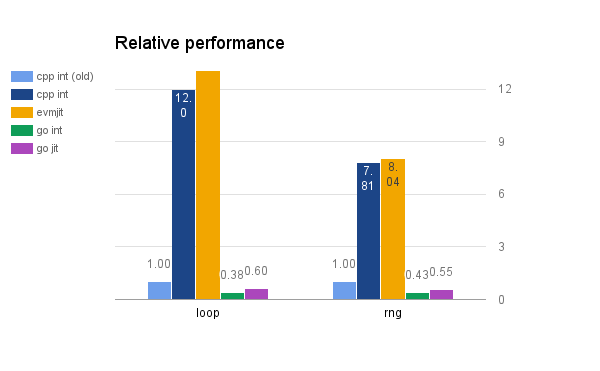For the reason that final C++ DEV Replace, loads of issues occurred within the engine room which have been probably not seen to the skin. This submit needs to provide an outline about what we’re at the moment engaged on.
Other than the options facet, Bob has been engaged on a proposed course of for re-licensing of the C++ runtime shopper code to Apache 2.0, as has been talked about a couple of occasions up to now month or two. Count on extra information on that very quickly.
Eth Unit-Check Mode
Not solely as a result of it’s important for having the ability to carry out our Solidity end-to-end exams by way of IPC, Dimitry Khoklov and others added some new RPC endpoints to the eth shopper which permit rather more flexibility for testing good contracts. When you use eth –test -d /tmp/check and hook up with the ipc port at /tmp/check/geth.ipc (we suggest utilizing ethereum-console for that as a result of it already has these options added) you possibly can:
- change the blockchain parameters (e.g. take away proof of labor checking and pre-fund sure accounts)
- mine a certain quantity of blocks (at round 30 blocks per second)
- modify the timestamp of the present block (to e.g. check timeouts in your contracts)
- revert the blockchain to a given block quantity
This enables us to run our at the moment 305 Solidity end-to-end exams in round 46 seconds on a average laptop. Every of those exams embody not less than two (typically extra) transactions and the identical quantity of mined blocks.
Extra details about these options could be discovered at https://github.com/ethereum/ethereum-console.
Please be aware that that is at the moment solely obtainable for the binary that’s offered by way of the ubuntu dev ppa.
Digital Machine Speedup
Greg Colvin spent the final months rushing up the C++ implementation of the EVM interpreter. He harvested what he calls the low-hanging fruits (he labored for Oracle on the Java interpreter earlier than…). An important enhancements to this point have been changing 256-bit calculations with 64-bit calculations for gasoline metering, and ensuring that no extra metering calculations are completed for every VM operation than mandatory. These and different modifications resulted within the following outcomes for Paweł Bylica’s nascent benchmark suite. The next chart exhibits the speedup relative to the previous cpp ethereum interpreter (cpp int (previous)).
To be honest, we now have to inform what these benchmarks measure. The primary benchmark (the place the evmjit goes off the dimensions with a speedup of 472x) does one million empty loops, and exhibits how gradual the EVM’s computed goto is in comparison with the direct leap of a JIT – fixing that’s subsequent on the stack. The second benchmark is a nasty random quantity generator that does one million loops with 4 multiplications and 4 additions per loop. It’s dominated by 256-bit calculations, so a JIT makes much less distinction. (Word that the Go JIT doesn’t compile to native code, however to a quicker interpreted illustration.)
In apply, these speedups will solely be related to “number-crunching” contracts as a result of the computation time is in any other case largely dominated by storage entry. Then again, the “rng” benchmark is sort of just like cryptographic operations which pulls such issues additional into the realm of precise on-chain implementations.
Paweł Bylica is engaged on a C-language interface between the digital machine implementation and the shopper that hosts it, with the aim of having the ability to plug completely different VMs into an Ethereum shopper. This manner, geth may doubtlessly profit from our modifications to the C++ digital machine and particularly from the LLVM just-in-time compiler.
Word that these modifications aren’t but launched, however they’re a part of the ubuntu dev ppa.
Remix
Yann Levreau and Liana Husikyan are engaged on our new EVM debugger remix. We launched the alpha model some days in the past:
For now, you possibly can “solely” use it to examine each single step within the execution of any transaction within the blockchain, have a look at the present stack, reminiscence and storage contents and see the sequence of directions. The following step shall be to additionally permit source-level debugging the place you possibly can see the present place within the supply code, step on line or instruction stage and see the decoded values of the variables (as an alternative of solely the uncooked hex values).
The debugger is for you, the group, and we have been delighted to listen to that etherscan has already built-in Remix into their blockchain explorer.
Repository Reorganisation
Bob Summerwill is devoted to bringing again C++-Ethereum to its former residence, https://github.com/ethereum/cpp-ethereum and thus take away the pointless and complicated break up into a number of sub-repositories. We’re making nice progress there, one of many first actually seen steps was to decouple the testing infrastructure of Solidity from the digital machine implementation. The Solidity exams can now be compiled with out the digital machine and they’re run by speaking with a specifically configured eth course of (the one talked about above) over the common IPC interface.
The following steps listed below are to disentangle the remainder of the code, modify the check automation and steady integration accordingly and carry out the precise transfer.
Along with this step, we sadly should say goodbye to Combine and AlethZero (the spirit of combine will dwell on within the new remix venture). The burden they drag alongside could be too massive, as a result of it consists of Qt and a decent coupling with Solidity. As already defined in earlier posts, a unfastened IPC-based coupling of those instruments to a small shopper implementation makes us rather more versatile and the group help that comes with a change to JavaScript and Internet-based instruments like remix and browser-solidity is simply overwhelming compared.
Formal Verification
We’re extending the prevailing formal verification instruments built-in with Solidity to cross-contract calls. This might allow automated proofs that e.g. a recursive name assault will not be doable towards a sure contract. Additionally, as why3 (the device we use to do the heavy lifting) was not too long ago ported to browsers, we are able to in all probability anticipate it to be obtainable proper inside browser-solidity and different instruments like blockchain explorers!
There’s a first proof of concept together with explanations that exhibits how automated verification can be utilized to point out that it’s not possible to steal cash from a solidity contract, even when recursive calls are allowed.
This proof of idea will hopefully evolve right into a usable device within the subsequent weeks.
A number of folks from the group and from contained in the Basis are at the moment engaged on instruments for Solidity or the EVM on the whole. These embody:
- Solidity AST evaluation for warnings by Dave Hoover (@redsquirrel)
- A Learn-Eval-Print model of Solidity by raineorshine: Solidity-repl
- Control-flow analysis graph additionally by raineorshine
- EVM disassembler by Nick Johnson






